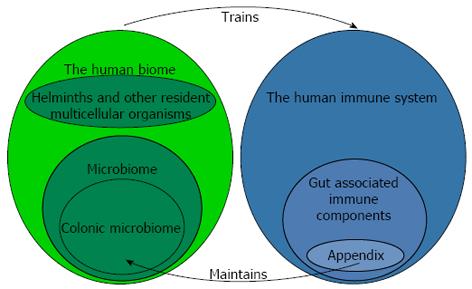Copyright
©2013 Baishideng Publishing Group Co.
World J Gastroenterol. Sep 14, 2013; 19(34): 5607-5614
Published online Sep 14, 2013. doi: 10.3748/wjg.v19.i34.5607
Published online Sep 14, 2013. doi: 10.3748/wjg.v19.i34.5607
Figure 1 Interactions between the human biome (left Venn diagram) and the human immune system (right Venn diagram).
In this view, all living organisms associated with the human body, either as permanent residents or through transient interactions, are part of the human biome. Two subsets of the biome, helminths and the microbiome, are shown as being part of the human biome. The colonic microbiome, in turn, is shown as being a subset of the microbiome in the Venn diagram of the human biome. Similarly, the appendix is shown as being a subset of the gut associated immune components, which in turn are a subset of the entire human immune system. The idea that the biome “trains” the immune system, equivalent to the view that the immune system is dependent on the biome for proper development, is illustrated. In this model, profound alterations in the biome as a result of post-industrial societies lead to aberrant immune system development, resulting in a variety of immune related pathologies, including appendicitis. The view that the appendix assists in maintaining of the colonic microbiome is also shown. Alterations in the biome that affect immune system training in post-industrial societies predominantly involve compartments of the biome other than the microbiome (e.g., loss of helminths), so the processes leading to appendicitis are generally distinct from processes involved in support of the microbiome by the appendix.
-
Citation: Sanders NL, Bollinger RR, Lee R, Thomas S, Parker W. Appendectomy and
Clostridium difficile colitis: Relationships revealed by clinical observations and immunology. World J Gastroenterol 2013; 19(34): 5607-5614 - URL: https://www.wjgnet.com/1007-9327/full/v19/i34/5607.htm
- DOI: https://dx.doi.org/10.3748/wjg.v19.i34.5607









